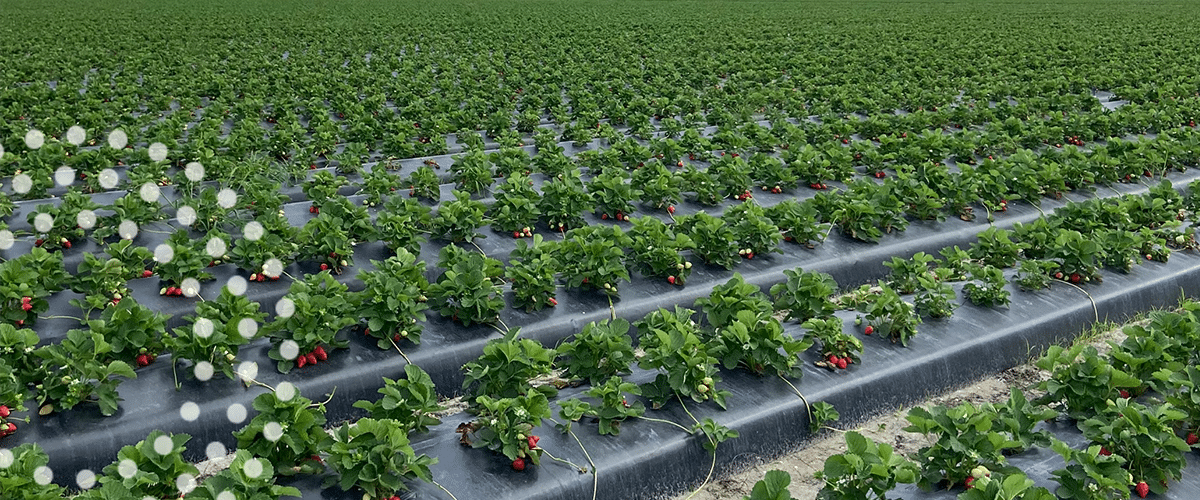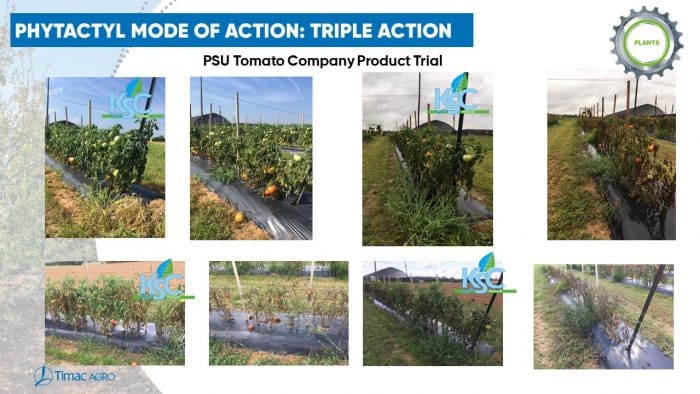Water-Soluble Fertilizers – Delivering Key Nutrients Through the Drip >>

Fertigation is widely used, especially in vegetable acres across the United States. The practice uses water-soluble fertilizers and allows for the delivery of key nutrients throughout the growing season, showing great benefits on produce quality and yield. As more and more growers show interest in transitioning to this method, let’s dive in on the benefits and challenges of this practice, as well as the high-quality inputs it requires to reach its full potential.
Fertigation = Fertilizing Through Irrigation
In a fertigation system, the fertilizer and water needed for crop growth are supplied simultaneously. It’s a practical method because it can be applied in the open ground, under glass, or even in hydroponics. By applying fertilizers via a fertigation system, the amount of nutrients can be adjusted according to the amount of water supplied to the crop and its needs.
Fertigation, what’s in it for crops?
Fertigation has many advantages for crops. It is beneficial from a nutritional point of view, for soil management, for improving yields, and even economically. With fertigation, nutrients are delivered to the plant in a form that enables it to assimilate them more quickly. The irrigation system, meanwhile, distributes these nutrients as close as possible to the roots to improve absorption efficiency. This also reduces the risk of too much fertilizer damaging the roots.
Thanks to this optimized distribution, fertigation helps to improve yields. It also facilitates the work of farmers, who can adapt the quantities they distribute and react in the event of a problem.
This method also has benefits for the environment. The optimization of water and nutrient resources avoids wastage and, above all, limits the phenomenon of leaching. The impact on the soil is reduced. As the products are dispersed directly by the irrigation system, there is no spreading and therefore no soil compaction. Finally, by reducing the areas in which the fertilizers are spread, there are fewer weeds in the plots.
Main Agronomic Issues from Fertigation
- Nutrient Imbalance: Fertigation can lead to imbalances in nutrient availability within the soil, affecting plant growth and yield. Uneven distribution or excessive application of certain nutrients can cause deficiencies or toxicities.
- Nutrient Leaching: Over-irrigation or heavy rainfall following fertigation can cause nutrients to leach below the root zone, reducing their availability to plants and causing environmental pollution of water bodies.
- Clogging of Irrigation Equipment: Fertilizers used in fertigation can contain particles or substances that may clog irrigation emitters, filters, or pipes, leading to uneven distribution of water and nutrients.
- Salinity Build-up: Continuous fertigation without proper management can contribute to the accumulation of salts in the soil, leading to soil salinity problems that hinder plant growth and productivity.
- pH Imbalance: Fertigation solutions may alter the pH of the soil, affecting nutrient availability and microbial activity. Uncontrolled changes in soil pH can lead to nutrient lockup or toxicity issues.
- Compatibility of Fertilizers: Mixing different types of fertilizers for fertigation requires careful consideration of their compatibility to avoid chemical reactions or precipitation that could reduce nutrient availability or damage irrigation equipment.
- Monitoring and Management: Continuous monitoring of soil nutrient levels, water quality, and crop response is essential for effective fertigation management. Lack of proper monitoring and adjustment can lead to inefficient nutrient use and reduced crop performance.
Water-Soluble Solutions Are the Right Choice for Fertigation
As their name suggests, water-soluble solutions are made up of elements that dissolve in water. They are a mixture of mineral elements designed to deliver nutrients to the plant to promote growth, yield, and crop quality.
With a water-soluble fertilizer, all the fertilizer dissolves in the water, there is no deposit and the water remains transparent (unless the fertilizer contains coloring agents). However, the quantity of fertilizer used must be controlled. There is always a risk of saturation. In this case, some of the water-soluble fertilizer will not be able to dissolve.
KSC®, a Water-Soluble Line Powered by the PHYTACTYL Complex
The KSC line of water-soluble fertilizers are a combination of high-quality, low salt nutrients and the patented PHYTACTYL® Complex. They are for fertigation or hydroponics in intensive crop production. The low salt index and low chloride content is safer for seedlings and allows better water and nutrient uptake.
KSC® formulations are created with:
- High water solubility
- High-quality raw materials with a very high chemical compatibility
- Nitrogen in ammonia and nitrate forms (no urea)
- The use of chelated trace elements to increase efficiency
- The use of raw materials without chlorine
- Buffering effect on pH and little impact on the electrical conductivity of the final solution, promoting the full development of plant
The PHYTACTYL Complex
The PHYTACTYL® Complex is our naturally-derived technology component of KSC® water-soluble fertilizers.
- It is a carbon compound and seaweed-derived complex
- Designed to improve and speed up root assimilation of nutrients
- Reduces salt stress
- Improves microbial activity and respiration to mineralize and mobilize nutrients and make them more available to plants
- Improves nutrient partitioning within the plant getting key nutrients to plant parts that are in high demand
PHYTACTYL® has three modes of action:
- Action on plants:
It contains selected extracts and organic acids that can partition the nutrients to the organs where growth needs are the greatest. Improved nutrient assimilation and biostimulation leads to:
- Uniform and stimulated growth stages like the root growth, vegetative growth, flowering, fruit set, and fruit finish.
- Quick and efficient stage transitions.
- Delay senescence process.

- Action on soil:
Nutrient mobilizing effects of selected organic compounds. The PHYTACTYL® Complex contains organic compounds and glucides. These specific organic compounds increase the availability of nutrients for the plant by mobilizing soil nutrients and stimulating soil microbes to release nutrients.
- Action on specific nutrition:
KSC PHYTACTYL has a range of different formulas perfectly adapted to:
- Highly soluble
- Helps in hard water and doesn’t drastically affect pH
- Low salt concentrations and no chloride or urea
KSC® Application Through Fertigation
The minimum application rate should be 8-42 lbs/acre of KSC per week split over 1 to 5 applications.
Dilute KSC in water with a maximum concentration of 10-20% or 1-2 lbs /gallon. This dilution should be considered as a guideline and should be adapted to the chemical characteristics of the irrigation water.
KSC is available in six different formulations that are specifically catered to diverse growing conditions and plant growth stages.
Packaging size: 55.125 lb bags

